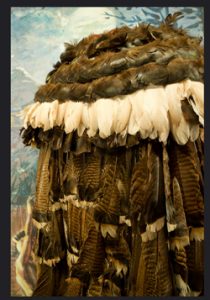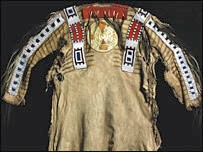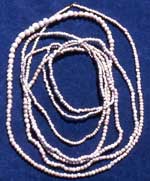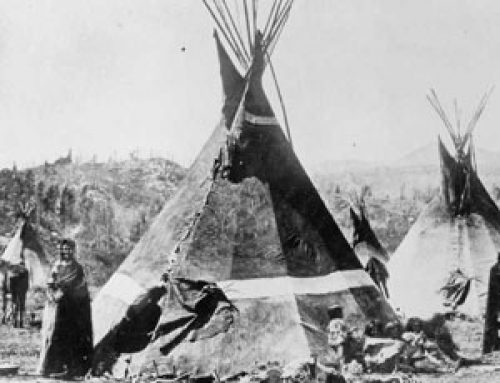
Native American clothing: Pueblo cotton cloth (before 1500 AD)
Native American cotton and agave
Most people in North America made their clothing from agave plant fiber – some of it grew wild, and some of it they farmed. Richer people wore cotton clothing. Cotton came originally from the Aztec people south of them.
The history of cotton
More Native Americans articles
Pueblo people spun and wove this cotton into clothes. They knitted it into socks. Men wore kilts (skirts) and women wore dresses, and they both wore ankle-high leather moccasins. These cotton clothes were appropriate for the hot weather of the south-west (modern Arizona, Colorado, and New Mexico).
History of leather
More about knitting

Pueblo cotton sock, made with nalbinding (Gourd Cave, ca. 1100-1300 AD) Now in Arizona State Museum
Native American bark clothing and feather cloaks
Further east, among the Mississippians and the Cherokee, there were fewer people, and they didn’t grow cotton or agave. They made their clothes out of the inner bark of trees; like people in Africa, they peeled off the bark, beat it until it was flexible, and then spun and wove it into cloth like linen. It was hard to tell this bark cloth apart from cotton. For fancy occasions, the Pueblo and the Mississippians and Cherokee all wore feather cloaks, which looked very impressive.
More about the Mississippians
More about Cherokee clothing

Cherokee feather cloak (Now in Museum of the Cherokee Indian)
Deerskin and rabbit skin clothing
The further north you went, the fewer people there were, and fewer of them had clothes made of cotton or agave or bark cloth. Instead, Native American clothing here was mostly deerskin or the skins of small animals like rabbits and squirrels sewn together. It was colder up north, and people needed warmer outfits. Also, agave and cotton wouldn’t grow up north. Women wore dresses or skirts, sometimes with leggings under them.
More about Chinook clothing
Some women spun and wove nettle fibers to make softer under-shirts to wear under their dresses. In cold weather they wrapped another deerskin around themselves as a coat. If it was hotter, many women went topless and just wore leggings and skirts.

A traditional Blackfoot men’s shirt (only with later European trade beads added)
Clothes were very expensive
Most men wore leggings and breechclouts (like shorts) made out of deerskin. When it was cold they wore deerskin robes. It was hard to get enough deerskins for everyone, so – just as in Europe or Asia at this time – most people only had one outfit, and some poor people and children didn’t own any clothes.
More about European clothing
Who were the Blackfoot?
Most people tried to make their clothes last as long as possible by not wearing them whenever it was warm enough, or if they were working hard. Sometimes women wore cheaper grass or moss skirts to save their deerskin clothes.

Pearl necklace from Craig Mound, Spiro (modern Oklahoma), ca. 1300 AD
Native American hairstyles and jewelry
People also showed what group they belonged to with their hairstyles. For instance, men who lived on the East Coast – like the Algonquins, the Cherokee, and the Iroquois – shaved most of the hair off their head and left only a little hair at the top of their head (today we call this a Mohawk or a Mohican after two of the groups that did this).
More about the Algonquin
But men who lived in the Plains – like the Sioux or the Blackfeet – kept their hair in two long braids along the side of their head. Pueblo men cut their hair off at neck-length.
More about the Pueblo people
More about the Sioux
Most Native women wore their hair long, often in one long braid down their back, but Chinook women, for instance, cut theirs to shoulder length.
People also used jewelry as part of their clothing. They often traded long distances to get special pearls or shells or copper to make into beads.
What are pearls?
Did you find out what you needed to know about Native American clothing history? Ask your questions in the comments!




good website for a school project actually working on one now helped a lot
I’m delighted to hear it, Kat! If you have a school website, or your teacher has a links page, we’d love for them to link to us and help spread the word!
Could you perhaps guess what kind of clothing Lozen wore when fighting? The best guess for Native Americans in the south west in 1877
You might want to read this article: https://quatr.us/north-america/american-clothing-1800s.htm
Images of the Apache warrior Lozen show her wearing lots of long strings of small white (bone or shell) beads, and a rawhide cape with more beads embroidered on it in patterns. She also appears wearing women’s cotton shirts in the European style, with pleats in the front. That’s typical of Apache women in the late 1800s: they sometimes wore rawhide capes and skirts, and sometimes wore European women’s dresses with rawhide capes and beads over them. Sometimes they did half-and-half, with a European shirt and a rawhide skirt, or the other way around. If I were Lozen, I’d have worn jeans, but I don’t know of any evidence that she did.
While beads made from oyster shells, bone, and other products were exchanged in trade, along with many other products, such as pottery, copper, furs, tools, seeds to be used for planting and other foods sources, and various other trade goods – Beads were Never, Ever used as money in Pre-Columbian America – the concept of money did not exist among the nations until after the arrival of the colonists. Beads were no more valuable than any other trade good.
The first European explorers and colonists … [sorry I had to delete this part of your post because it is plagiarized from Kathy Fox, The Venetian Glass Bead, p. 13 – anyone who is interested can go read the passage there.]
While I appreciate your strong feelings on this subject, Ms. Bridges, I don’t agree with you. Beads don’t have to be more valuable than anything else in order to serve as a kind of money: pennies, for example, are money, even though almost everything is worth more than a penny.
You’ll find more about this in, for example, Glyn Davies’ History of Money (2010) or Jerry Martien’s Shell Game: A True Account of Beads and Money Shell Game: A True Account of Beads and Money (1996).
I am curious about beads from the little I know it seems the natives traded all sorts of things for beads, what did they use prior to the whites coming? Did beads have value and if so why
Hi Jo,
Native Americans used beads as a kind of money long before they saw the first European beads. They made beads out of seashells, and out of colorful rocks, and carved them out of wood. Beads make good money because they are obviously valuable (either they’re made out of something rare, or they took a lot of work to carve, or both), and they’re small and light. You can carry a lot of them easily by stringing them on a necklace or weaving them into a belt, but you can take one bead off to trade for something small, too. Even if you don’t personally like beads, it’s never hard to find someone who does.
When Europeans came, Native people were excited to get new kinds of beads – glass beads! – that seemed like they would be worth a lot. But as the Europeans brought more and more of them, they became less rare and were worth less.
You can find out more in our article on the history of money: https://quatr.us/economy/invented-money-history-money.htm
Thanks this helps alot!
Happy to hear it, Livia!